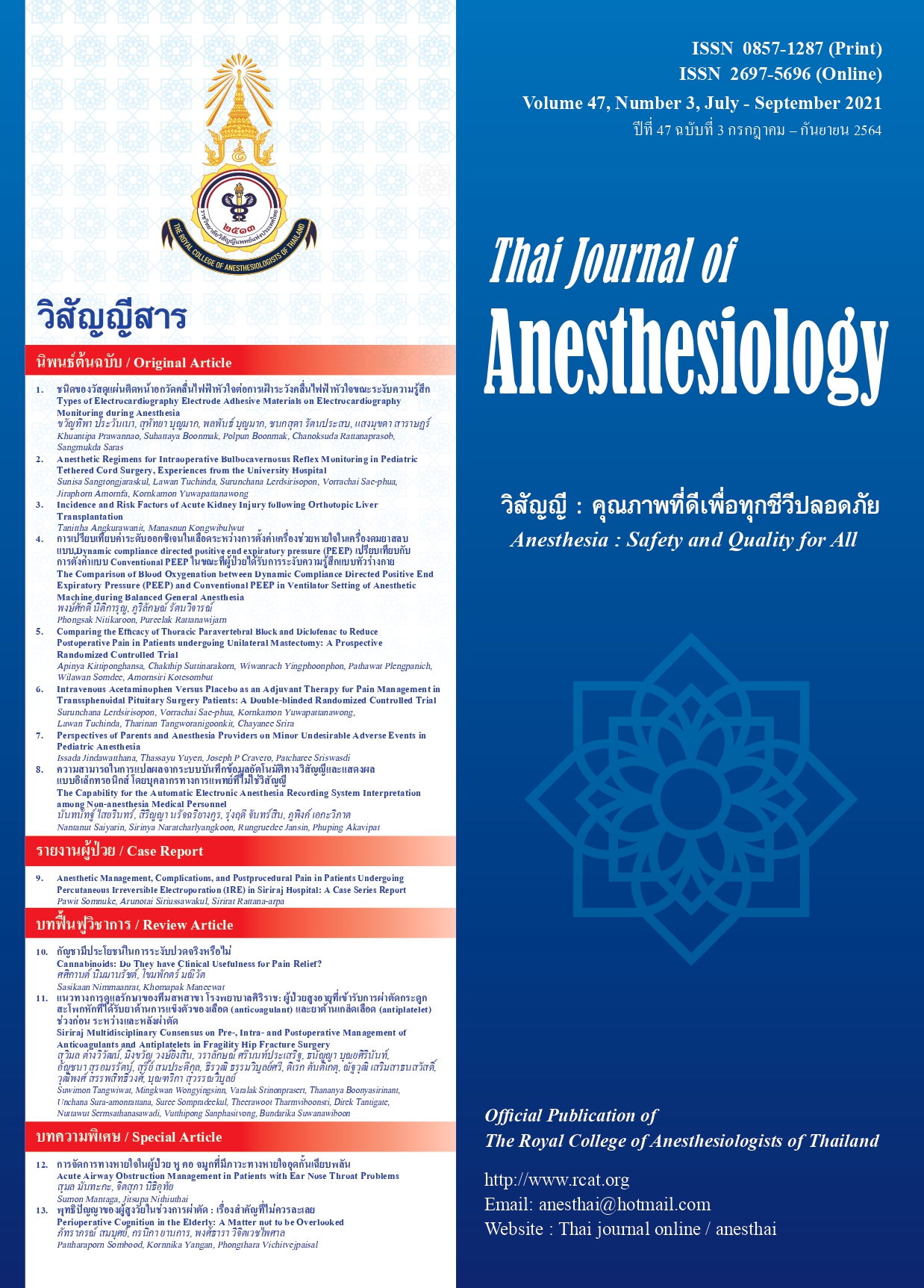Perspectives of Parents and Anesthesia Providers on Minor Undesirable Adverse Events in Pediatric Anesthesia
Main Article Content
บทคัดย่อ
Background: Decreasing the incidence of minor adverse events improves parental satisfaction in pediatric anesthesia. Previous studies have ranked these adverse events from only one perspective (either parents’ or anesthesia personnel’s). Objectives: This study was designed to determine the participants’ rankings of minor adverse events and compare them among parents and anesthesia providers. This study also investigated the correlations between the care priorities and their previous anesthesia experiences. Methods: We conducted a single-center, prospective study on 156 participants. Questionnaires were administered to three groups: Parent group (n, 101), Anesthesiologist group (n, 37), and Postanesthesia care unit nurse (PACU-nurse) group (n, 18). The respondents ranked seven predefined minor adverse events from the most undesirable (“1”) to the least undesirable (“7”). Details of previous anesthesia experiences of themselves and their children were also collected. Results: For the parents, the most important to avoid was pain (average ranking, 2). Whereas the anesthesiologists and PACU-nurses focused more on postoperative behavioral change (average ranking, 1). Sixty-eight percent of the parents with prior postoperative pain rated pain as the most undesirable side effect for their children (OR 3.6 [1.2-11.4]; P=0.027). Conclusions: There was a divergence between the parents’ and the anesthesia personnel’s views on the minor anesthesia adverse events to avoid. The parents’ priorities for their children’s anesthetic care were influenced by their previous experiences, especially those with prior postoperative pain. To improve parental satisfaction, anesthesia providers should know which are the parental expectations and preferences.
Article Details

อนุญาตภายใต้เงื่อนไข Creative Commons Attribution-NonCommercial-NoDerivatives 4.0 International License.
เอกสารอ้างอิง
Pediatr Surg 2018;17:141-51.
2. Paterson N, Waterhouse P. Risk in pediatric anesthesia.
Paediatr Anaesth 2011;21:848-57.
3. Mattila K, Toivonen J, Janhunen L, Rosenberg PH, Hynynen M.
Postdischarge symptoms after ambulatory aurgery: first-week
incidence, intensity, and risk factors. Anesth Analg 2005;
101:1643-50.
4. Wagner DS, Yap JM, Bradley KM, Voepel-Lewis T. Assessing
parents preferences for the avoidance of undesirable
anesthesia side effects in their children undergoing surgical
procedures. Paediatr Anaesth 2007;17:1035-42.
5. Rhondali O, Villeneuve E, Queyrel G, et al. Fast-track recovery
after day case surgery. Paediatr Anaesth 2015;25:1007-12.
6. Macario A, Weinger M, Truong P, Lee M. Which clinical
anesthesia outcomes are both common and important to
avoid? the perspective of a panel of expert anesthesiologists.
Anesth Analg 1999;88:1085-91.
7. Lew VK, Lalwani K, Palermo TM. Factors affecting parental
satisfaction following pediatric procedural sedation. J Clin
Anesth. 2010;22:29-34.
8. Iacobucci T, Federico B, Pintus C, Francisci G. Evaluation
of satisfaction level by parents and children following
pediatric anesthesia. Paediatr Anaesth 2005;15:314-20.
9. Perrott C, Lee C-A, Griffiths S, Sury MRJ. Perioperative
experiences of anesthesia reported by children and parents.
Paediatr Anaesth 2018;28:149-56.
10. Gidman W, Elliott R, Payne K, Meakin GH, Moore J. A comparison
of parents and pediatric anesthesiologists’ preferences for
attributes of child daycase surgery: a discrete choice
experiment. Paediatr Anaesth 2007;17:1043-52.
11. Höhne C. Postoperative nausea and vomiting in pediatric
anesthesia. Curr Opin Anaesthesiol 2014;27:303-8.
12. Walker SM. Pain after surgery in children: clinical
recommendations. Curr Opin Anaesthesiol 2015;28:570-6.
13. Karling M, Stenlund H, Hägglöf B. Child behaviour after
anaesthesia: associated risk factors. Acta Paediatr 2007;
9:740-7.
14. Whippey A, Kostandoff G, Ma HK, Cheng J, Thabane L, Paul J.
Predictors of unanticipated admission following ambulatory
surgery in the pediatric population: a retrospective
case-control study. Paediatr Anaesth 2016;26:831-7.
15. Macario A, Weinger M, Carney S, Kim A. Which clinical
anesthesia outcomes are important to avoid? the perspective
of patients. Anesth Analg 1999;89:652-8.
16. Sikich N, Carr A, Lerman J. Parental perceptions, expectations
and preferences for the postanaesthetic recovery of children.
Paediatr Anaesth 1997;7:139-42.
17. Stargatt R, Davidson AJ, Huang GH, et al. A cohort study of
the incidence and risk factors for negative behavior changes
in children after general anesthesia. Paediatr Anaesth
2006;16:846-59.
18. Sirivanasandha P. Postoperative nausea vomiting (PONV):
influence of bowel manipulation during intraabdominal
surgery. J Med Assoc Thai 1995;78:547-53.
19. Sriswasdi P, Thamkhantho M. Satisfaction with pediatric
anesthesia services: analysis of factors. J Med Assoc Thai
2019;102:794-800.
20. Fincham J. Response rates and responsiveness for surveys,
standards, and the journal. Am J Pharm Educ 2008;72:43.


